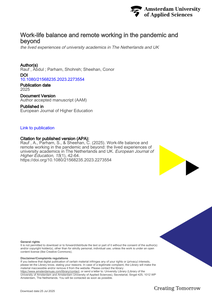This research report contains the findings of an international study consisting of three online ‘living’ surveys. The surveys focused on how the COVID-19 pandemic has impacted sign language interpreters’ working practices, how this was experienced by them, and how digital disruption caused by the pandemic is impacting and innovating the sign language interpreting profession. The study was carried out between April 2020 and July 2020; the largest contingent of respondents over all three surveys were from the U.S., followed by the UK, the Netherlands, Germany, Finland and Belgium. Respondents commented that the crisis will probably accelerate the need for remote interpreting training in interpreter training programs. Another resurfacing issue was the perceived need for sign language interpreting students to have face-to-face practice and live mentoring. Respondents commented on what benefits they thought remote interpreting might bring to the table, both for themselves and for deaf people. In general, the most significant benefits that were mentioned were flexibility and the possibility to improve efficiency and availability of sign language interpreting services. Notwithstanding these benefits, a significant number of respondents claimed that remote interpreting is more stressful than face-to-face interpreting and requires a heavier cognitive load.
DOCUMENT

Poor work-life balance (WLB) has been linked to negative outcomes such as increased stress, anxiety, depression, and a perceived reduction in the overall quality of life. At an institutional level, these may include lowered employee commitment and decreased productivity at work. The advent of COVID-19 has necessitated fundamental alterations to work experience and the ways in which WLB may be perceived. This phenomenological study employed qualitative, in-depth interviews to explore higher education academics’ lived experiences of remote working and how they perceived this had impacted their well-being (WB) and WLB. Using purposive samplings, respondents were drawn from HE sectors in the Netherlands, and the UK. The findings offered an understanding of how remote and hybrid teaching delivery during the pandemic affected academics’ actual experiences of WB and WLB. These findings serve to enhance policymakers’ understandings of significant occupational health and WB issues within a post-pandemic education service paradigm.
DOCUMENT

Background: Remote coaching might be suited for providing information and support to patients with coronary artery disease (CAD) in the vulnerable phase between hospital discharge and the start of cardiac rehabilitation (CR).Objective: The goal of the research was to explore and summarize information and support needs of patients with CAD and develop an early remote coaching program providing tailored information and support.Methods: We used the intervention mapping approach to develop a remote coaching program. Three steps were completed in this study: (1) identification of information and support needs in patients with CAD, using an exploratory literature study and semistructured interviews, (2) definition of program objectives, and (3) selection of theory-based methods and practical intervention strategies.Results: Our exploratory literature study (n=38) and semistructured interviews (n=17) identified that after hospital discharge, patients with CAD report a need for tailored information and support about CAD itself and the specific treatment procedures, medication and side effects, physical activity, and psychological distress. Based on the preceding steps, we defined the following program objectives: (1) patients gain knowledge on how CAD and revascularization affect their bodies and health, (2) patients gain knowledge about medication and side effects and adhere to their treatment plan, (3) patients know which daily physical activities they can and can’t do safely after hospital discharge and are physically active, and (4) patients know the psychosocial consequences of CAD and know how to discriminate between harmful and harmless body signals. Based on the preceding steps, a remote coaching program was developed with the theory of health behavior change as a theoretical framework with behavioral counseling and video modeling as practical strategies for the program.Conclusions: This study shows that after (acute) cardiac hospitalization, patients are in need of information and support about CAD and revascularization, medication and side effects, physical activity, and psychological distress. In this study, we present the design of an early remote coaching program based on the needs of patients with CAD. The development of this program constitutes a step in the process of bridging the gap from hospital discharge to start of CR.
DOCUMENT
